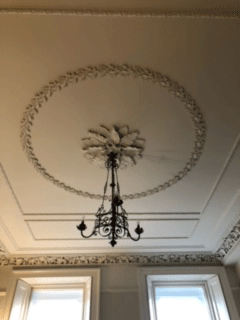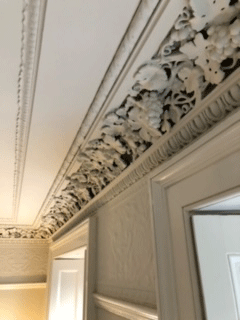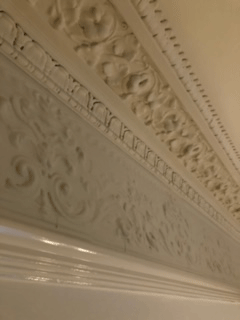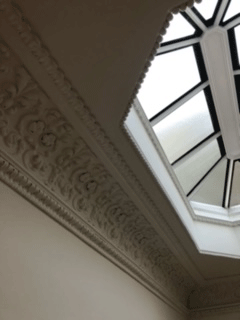The History of 10 Lewes Crescent
1 Francis Sherriff
2 Accident at the William IV Gate
3 Captain Taylor
4 Bas Reliefs
5 Plasterwork
1 Francis Sherriff
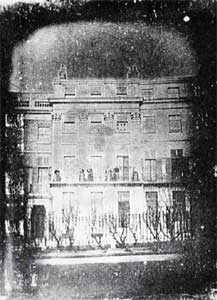
This daguerrotype of 10 Lewes Crescent was made by William Constable, Brighton’s first professional photographer. It comes from the collection of Richard Dykes Alexander of Ipswich, who is said to be among those pictured standing on the balcony. Dykes Alexander was a Quaker banker, pacifist and keen supporter of the abolition of slavery. He gave land for housing In Ipswich on condition that the new streets were named after leading British and American abolitionists.
The image was taken around 1845. At about this time the owner of 10 Lewes Crescent was Francis Sherriff (1801-1897). He may be among those pictured. Although only 44, Sherriff had retired a wealthy man from the calico printing business, he had set up with two partners, George Gillett and Richard Cobden. Cobden, was the leading advocate of free trade and the repeal of the Corn Laws which protected the price of corn for English landowners from foreign competition. The effect on the poor, who relied on corn for bread and beer, was severe. Cobden used the £40,000 share he took from the partnership with Sherriff and Gillett to set up ragged schools for the poor and to pursue the cause of free trade. He succeeded, eventually, in his campaign and the Corn Laws were repealed but not before he had practically bankrupted himself in pursuing the cause.
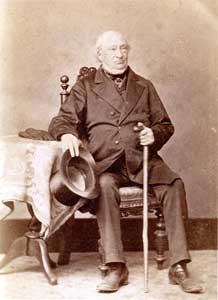
If Mr Sherriff’s milieu at this time was liberal, if not radical thinkers, his neighbours at Lewes Crescent were of a different world view. ( See No 9 and No 11 Lewes Crescent )
Francis Sherriff has his place in Brighton history as being the man carried away from the Royal Pavilion on a litter to his home in Lewes Crescent with his legs broken and collarbone fractured and in a ‘very precarious state’. One of the massive timber gates of the William IV gate fell on him and others sheltering from a storm there in February 1852. The incident, in which a young woman was killed, shocked Brighton at the time. During his long convalescence, Francis Sherriff took a sea voyage to see the new colony of New Zealand. He eventually emigrated there with his family and died there in 1897.
Andrew Doig
The Accident at the William IV Gate
Given the difficulty of closing The William IV Gate in the Royal Pavilion Estate, the night before, Bill Snow decided against opening it on Tuesday and retired to his warm rooms.
The weather on Tuesday 10 February 1852 was very unsettled. Bill only opened the eastern gate and huddled in his Lodge against the squalls. Late in the afternoon the bad weather intensified, and the skies turned black. Hail, rain and sleet followed and passers by took shelter in the gateway, just as they do today.
The wind blew in gusts from all directions and as the crowd grew, there was laughter and embarrassment as the ladies skirts were blown. Just before four o’clock, the rain became horizontal while sunlight picked its way through the mist creating dancing rainbow effects. Then an almighty gust blew.
In his Lodge Bill heard a loud rumbling noise like thunder followed by a loud bang.
Outside, Mrs Langridge and her two daughters were enjoying the dramatic storm but as she too heard the noise, she called to her little girls, “run, run” as she saw the gate collapse inwards.
Amidst loud screams, she saw with horror that although her youngest had escaped, her 12 year old had been caught by the gate as it fell, knocking her unconscious, bleeding and left lying partially under the gate, injuring her feet. Most horribly, it was clear that other people had also fallen and lay crushed under the gate.
In silence, the men struggled to lift the gate and the injured were removed. The gate was let down again, injuring another in the process. One of the injured was a young woman and the other a gentleman, both severely wounded.
A doctor was called for and one of the men ran across the gate, but it being wet he slipped and fell heavily. Picking himself up he ran to get the well known and respected doctor ,Mr John Lawrence Senior, who lived nearby at Grand Parade, and was the late Surgeon to the Sussex County Hospital. He asked for his urgent assistance to a dreadful accident, and jumping into his carriage, Mr Lawrence was there in under half a minute, soon joined by his son John Lawrence junior, the then current House Surgeon at the Hospital.
Meanwhile Mrs Langridge, wife of the Sussex Clerk of the Peace was bemoaning the injuries to her 12 year old daughter. A man lay in great pain with badly damaged legs – he was Mr Sherriff, a gentleman who lived in Lewes Crescent. Not only were both bones of his right leg broken near the ankle, but also his chest had been badly bruised and his collarbone broken.
But most pitiful of all was a young woman of about 30, recognised by many as Martha Mitchelson, the only daughter of a gentleman who lived at 10 Grand Parade. Her father was called for. Mr Lawrence called for brandy and water and administered it to the young girl, who quickly revived. Then they gave the same to Miss Mitchelson who although conscious did not appear to revive, but said that she was dying.
Passing on to Mr Sherriff, the brandy was gratefully received but he urged both father and son to attend to the ladies and not mind him. He went back to the child and finding that she was much recovered, ordered her to be removed to her father’s house at 5 Marlborough Place where he briefly attended her, bathed her face and wrapped her in warm blankets.
He returned to the scene where his son was attending Miss Michelson. Seeing that she appeared to be incapable of moving neither legs nor arms, and complaining of severe back pain, they diagnosed a broken back and internal bleeding. Her father arrived in less than 10 minutes and rushed to his daughter’s side. “Father” she said, “I am dying”. He turned to Mr Lawrence and asked if this could be true. Sadly, both father and son agreed that she would be dead within 5 minutes. In fact, she lived less than that and was gone.
Both Mr Sherriff and young Miss Langridge survived their injuries. The inquest which followed on Wednesday evening and Thursday morning concluded that there was no undue negligence to be attached to any of the players in this sad affair and that the cause of this melancholy accident was a violent and sudden gust of wind acting on a damaged section of the gate.
They recommended that all the cast iron hinges be replaced by more suitable wrought iron to prevent a reoccurrence of this tragedy. Despite this adjudication, the Surveyor, Mr Stickney, was compelled to resign.
The account of this appalling incident was constructed from detailed accounts and evidence given to newspaper reporters and to the inquest which soon followed, all of which were printed in the pages of the Brighton Herald and the Brighton Guardian. Both of these publications can be found in Brighton History Centre.
Glenys Horton
3 Captain J A Taylor
More memories of Earlier Kemp Town published in the Brighton Herald 26 March 1892 by William Baines
Bare knuckle boxing
The house was afterwards occupied by Captain Taylor. He had staying with him on one occasion Mr.Featherstonehaugh, the old sporting squire, who told the writer that it was his(the writer’s) “duty” to see the approaching fight between Sayers and Heenan, and.said the grand old sportsman, with all the fire of his younger days, “I sawCribb and Molyneux fight, and saw Molyneux knocked down and his jaw broken andget up again and go at it as if nothing had occurred”. He added “But thisSayers is a very remarkable fellow”.
J A Taylor lived at no 10 Lewes Crescent 1862-1882.
The world’s first ‘world title’ boxing match between American John Heenan and TomSayers, ‘The Brighton Titch’ 17th April 1860. The result, a draw when police broke up the fight. This fight is in the era before Queensbury Rules of 1867 and illegal.Tom Cribb and Tom Molineaux, a black man, formerly a slave, from America. Theyfought a bare knuckle fight in December 1810. Winner declared when opponent iseither beaten unconscious or quits. Cribb won after Molineaux collapsed unconscious.
To read more memories of Kemp Town find the Article by Andrew Doig on the Estate page
4.Cubitt Project 1823-2023
The KTS Cubitt Research Project undertaken to mark the 2023 Centenary aims to establish which, if any, other houses on the Estate may have been built by Thomas Cubitt.
These photographs of the interior of No 10 Lewes Crescent show all the features associated with a typical ‘Cubitt house’ although, at the present time there is no known corroborative documentation.
The house has two bas reliefs, two of which are by Bertol Thorvaldsen. Morning and Night were hugely popular at the time he created them, around 1812, and miniature versions can still be obtained today on Ebay.
Morning can be found in 17 Lewes Crescent, 7 Chichester Terrace and 42 Sussex Square.
Night is also in 17 Lewes Crescent and 42 Sussex Square
The book, Hidden Treasures on the Kemp Town Estate by Vanessa Minns, published by KTS, illustrates and documents the provenance of all the 40 bas reliefs on the Estate and indicates where they can be found in other Houses in this country (Chatsworth, Osborne House) It can be purchased on Amazon from 1 May 2023
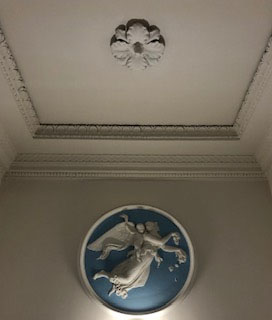
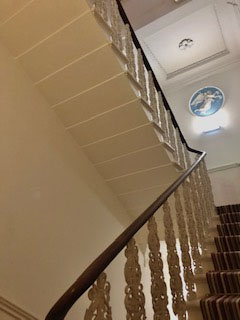
5 Plasterwork
